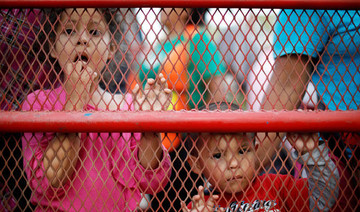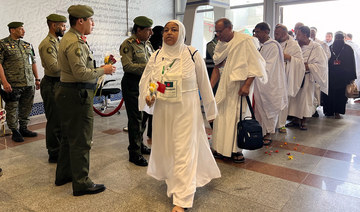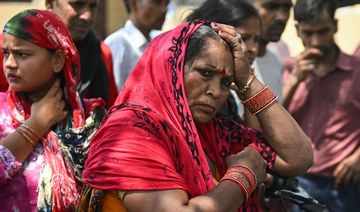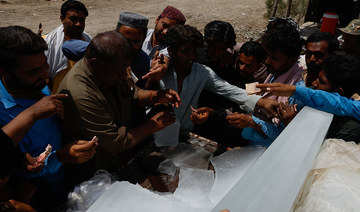TIJUANA, Mexico: Hundreds of Tijuana residents congregated around a monument in an affluent section of the city south of California on Sunday to protest the thousands of Central American migrants who have arrived via caravan in hopes of a new life in the US
Tensions have built as nearly 3,000 migrants from the caravan poured into Tijuana in recent days after more than a month on the road, and with many more months ahead of them while they seek asylum. The federal government estimates the number of migrants could soon swell to 10,000.
US border inspectors are processing only about 100 asylum claims a day at Tijuana’s main crossing to San Diego. Asylum seekers register their names in a tattered notebook managed by migrants themselves that had more than 3,000 names even before the caravan arrived.
On Sunday, displeased Tijuana residents waved Mexican flags, sang the Mexican national anthem and chanted “Out! Out!” in front of a statue of the Aztec ruler Cuauhtemoc, 1 mile (1.6 kilometers) from the US border. They accused the migrants of being messy, ungrateful and a danger to Tijuana. They also complained about how the caravan forced its way into Mexico, calling it an “invasion.” And they voiced worries that their taxes might be spent to care for the group.
“We don’t want them in Tijuana,” protesters shouted.
Juana Rodriguez, a housewife, said the government needs to conduct background checks on the migrants to make sure they don’t have criminal records.
A woman who gave her name as Paloma lambasted the migrants, who she said came to Mexico in search of handouts. “Let their government take care of them,” she told video reporters covering the protest.
A block away, fewer than a dozen Tijuana residents stood with signs of support for the migrants. Keyla Zamarron, a 38-year-old teacher, said the protesters don’t represent her way of thinking as she held a sign saying: Childhood has no borders.
Most of the migrants who have reached Tijuana via caravan in recent days set out more than a month ago from Honduras, a country of 9 million people. Dozens of migrants in the caravan who have been interviewed by Associated Press reporters have said they left their country after death threats.
But the journey has been hard, and many have turned around.
Alden Rivera, the Honduran ambassador in Mexico, told the AP on Saturday that 1,800 Hondurans have returned to their country since the caravan first set out on Oct. 13, and that he hopes more will make that decision. “We want them to return to Honduras,” said Rivera.
Honduras has a murder rate of 43 per 100,000 residents, similar to US cities like New Orleans and Detroit. In addition to violence, migrants in the caravan have mentioned poor economic prospects as a motivator for their departures. Per capita income hovers around $120 a month in Honduras, where the World Bank says two out of three people live in poverty.
The migrants’ expected long stay in Tijuana has raised concerns about the ability of the border city of more than 1.6 million people to handle the influx.
While many in Tijuana are sympathetic to the migrants’ plight and trying to assist, some locals have shouted insults, hurled rocks and even thrown punches at them. The cold reception contrasts sharply with the warmth that accompanied the migrants in southern Mexico, where residents of small towns greeted them with hot food, campsites and even live music.
Tijuana Mayor Juan Manuel Gastelum has called the migrants’ arrival an “avalanche” that the city is ill-prepared to handle, calculating that they will be in Tijuana for at least six months as they wait to file asylum claims. Gastelum has appealed to the federal government for more assistance to cope with the influx.
Mexico’s Interior Ministry said Saturday that the federal government was flying in food and blankets for the migrants in Tijuana.
Tijuana officials converted a municipal gymnasium and recreational complex into a shelter to keep migrants out of public spaces. The city’s privately run shelters have a maximum capacity of 700. The municipal complex can hold up to 3,000.
At the municipal shelter, Josue Caseres, 24, expressed dismay at the protests against the caravan. “We are fleeing violence,” said the entertainer from Santa Barbara, Honduras. “How can they think we are going to come here to be violent?“
Some from the caravan have diverted to other border cities, such as Mexicali, a few hours to the east of Tijuana.
Elsewhere on Sunday, a group of 200 migrants headed north from El Salvador, determined to also find safety in numbers to reach the US Edwin Alexander Gomez, 20, told AP in San Salvador that he wants to work construction in New York, where he hears the wages are better and the city is safer.
US President Donald Trump, who sought to make the caravan a campaign issue in the midterm elections, used Twitter on Sunday to voice support for the mayor of Tijuana and try to discourage the migrants from seeking entry to the US
Trump wrote that like Tijuana, “the US is ill-prepared for this invasion, and will not stand for it. They are causing crime and big problems in Mexico. Go home!“
He followed that tweet by writing: “Catch and Release is an obsolete term. It is now Catch and Detain. Illegal Immigrants trying to come into the USA., often proudly flying the flag of their nation as they ask for US Asylum, will be detained or turned away.”
Tijuana protesters chant ‘Out!’ at migrants camped in city
Tijuana protesters chant ‘Out!’ at migrants camped in city
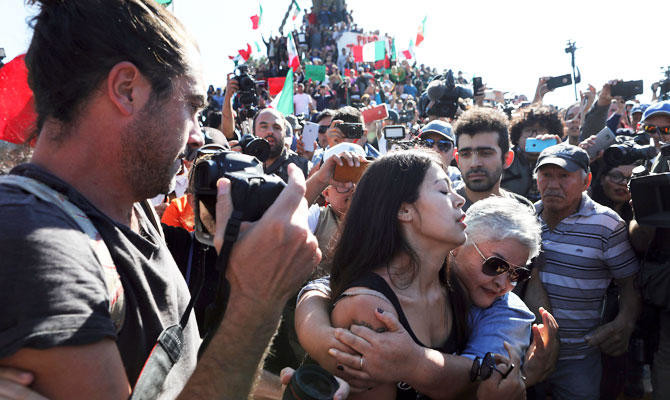
- The migrants’ expected long stay in Tijuana has raised concerns about the ability of the border city of more than 1.6 million people to handle the influx
Russia invites Taliban to top economic forum in June, TASS reports

TASS reported on Monday that Russian ministries advised Putin that Moscow could remove the Taliban from its listed of banned organizations.
Philippines protests China’s annual fishing ban

- China imposes an annual fishing ban on South China Sea waters and the Philippines routinely opposes it
- China claims almost the entire South China Sea, a conduit for more than $3 trillion in annual ship commerce
The annual imposition of a fishing ban raises tensions in the South China Sea, the foreign ministry said, calling on Beijing to “cease and desist” from “illegal actions” that violate the Philippines’ sovereignty and sovereign rights.
China imposes an annual fishing ban on South China Sea waters and the Philippines routinely opposes it. This year’s ban is expected to last until September.
The Philippines’ foreign affairs department (DFA) has protested the ban through a diplomatic note, saying the fishing moratorium covers waters within its maritime zones.
“The Philippines stressed that the unilateral imposition of the fishing moratorium raises tensions in the West Philippine Sea and the South China Sea,” the DFA said in a statement.
China’s embassy in Manila did not immediately respond to a request for comment.
Philippine Defense Secretary Gilberto Teodoro last week said China’s rules about how its Coast Guard can operate in the South China were a
“provocation.”
China claims almost the entire South China Sea, a conduit for more than $3 trillion in annual ship commerce. Its territorial claims overlap with waters claimed by the Philippines, Vietnam, Indonesia, Malaysia and Brunei.
In 2016, an international arbitral tribunal said China’s claims had no legal basis, a decision Beijing has rejected.
Indonesia’s Mountain Ibu erupts as agency warns local aviation authorities

- This follows a series of eruptions this month after authorities noticed an uptick of volcanic activity since April
JAKARTA: A volcano on the remote Indonesian island of Halmahera erupted on Monday spewing a grey ash cloud six km (four miles) into the sky, the country’s volcanology agency said, adding it had issued a warning for aviation authorities managing local flights.
This follows a series of eruptions this month after authorities noticed an uptick of volcanic activity since April, leading to evacuations of people from seven nearby villages.
“The ash column is seen to be thick and grey and moving westward,” the agency said, adding the eruption occurred at 3 a.m. local time (7 p.m. GMT) and recommending that a seven-km (4.35-mile) radius be cleared.
Footage shared by the agency on Monday showed the volcano spewing ash that grew thicker and eventually obscured it.
The agency also issued a “red” color code warning to local aviation authorities on Monday, the highest of its kind due to ash exceeding six km in height, its website stated.
It previously raised the alert level of the volcano to the highest on its scale on May 16.
Ibu’s activities follow a series of eruptions of different volcanoes in Indonesia, which sits on the Pacific “Ring of Fire” and has 127 active volcanoes.
Flash floods and cold lava flow from Mount Marapi, one of the most active in West Sumatra province, covered several nearby districts following torrential rain on May 11, killing at least 62 people with 10 people still missing.
In recent weeks North Sulawesi’s Ruang volcano has erupted, spewing incandescent lava. The eruption prompted authorities to evacuate more than 12,000 people on a nearby island.
Myanmar’s Rohingya in the crosshairs as fighting escalates in Rakhine
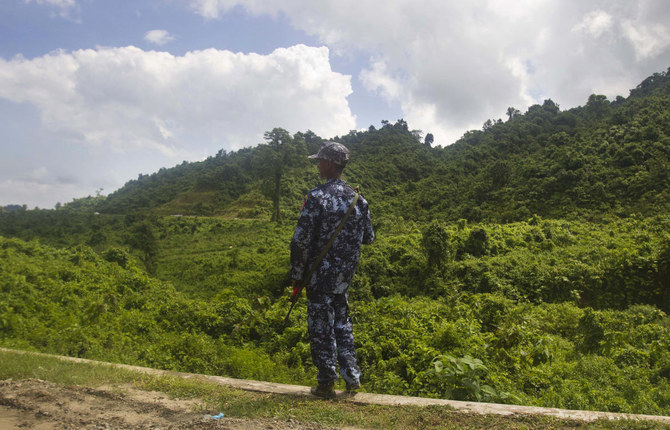
- Tens of thousands of Rohingya are estimated to have fled for safety toward neighboring Bangladesh since mid-May
NAYPVIDAW: Myanmar’s Muslim-minority Rohingya community is once again under threat of attacks and displacement as fighting between a powerful ethnic army and the country’s ruling junta escalates in the western state of Rakhine, according to UN and aid agencies.
Tens of thousands of Rohingya are estimated to have fled for safety toward neighboring Bangladesh since mid-May, which is reluctant to accept more refugees, and many of those remaining in Rakhine are in dire need of humanitarian aid.
The Arakan Army (AA) claimed control of Buthidaung town earlier in May following fighting during which the ethnic army was accused of singling out Rohingya community members. The AA denies the charges.
Reuters could not independently verify the claims, and a junta spokesperson did not respond to requests for comment.
The AA is now bearing down on the border town of Maungdaw, also home to a large Rohingya population, that the Myanmar junta will likely attempt to hold, raising the spectre of more serious violence.
“We see clear and present risks of a serious expansion of violence as the battle for neighboring Maungdaw town has begun — where the military maintains outposts and where a large Rohingya community lives,” a spokesperson for the UN High Commissioner for Human Rights said.
The Rohingya have faced decades of persecution and, after a 2017 crackdown by the military, nearly one million fled to Bangladesh, where many now live in crowded refugee camps.
Mohammed Taher, a Rohingya refugee in Bangladesh, said he had recently spoken to a friend in Maungdaw, who described the community living in fear.
“Many want to flee from Rakhine but Bangladesh is not opening its door for Rohingya,” Taher said.
Recent fighting has forced some 45,000 Rohingya to flee to an area along the Naf river on the border, according to a UN estimate.
“No Rohingya will be allowed to enter Bangladesh,” a senior Bangladesh border guard official told Reuters last week.
Myanmar has been in turmoil since a 2021 military coup, which spurred a grassroots armed resistance that is fighting the junta alongside long-established ethnic minority rebel groups.
’CAUGHT IN THE MIDDLE’
The fighting in Rakhine broke out last November when a ceasefire between the AA and the junta collapsed, leading to a string of battlefield successes for the rebels.
“Faced with mounting losses in Rakhine, the regime has resorted to arming members of the Rohingya ethnic minority to counter the Arakan Army’s advance,” Morgan Michaels of the International Institute for Strategic Studies said in a May report.
“The AA has reacted with inflammatory rhetoric and violence directed at the Rohingya.”
Amid the renewed conflict, Rohingya civilians are “increasingly being caught in the middle,” the United Nations Office for the Coordination of Humanitarian Affairs (OCHA) said in its latest report last week.
The agency estimates that over 350,000 people are displaced across Rakhine after years of conflict, many of whom do not have access to basic services.
“We are witnessing a near total absence of humanitarian assistance for communities who rely on it,” medical charity Medecins Sans Frontieres said, adding that hospitals in Buthidaung and Maungdaw were closed.
The AA, which has a goal to form an autonomous state, has warned that more battles are coming, asking civilians in Buthidaung, Maungdaw, and Thandwe to dig bomb shelters or evacuate to safer areas.
The group, which has denied it has targeted the Rohingya, has also asked for international aid for some 200,000 internally displaced people that it says are sheltering in areas under its control in Buthidaung and Maungdaw.
“The situation is incredibly fraught and dangerous,” said Scot Marciel, a former USambassador to Myanmar.
“In some ways, this is an early test of whether a post-military-rule Rakhine State with significant autonomy can work.”
33 Muslims arrested for attacking 2 Christian men on allegations of desecrating Qur’an in Pakistan
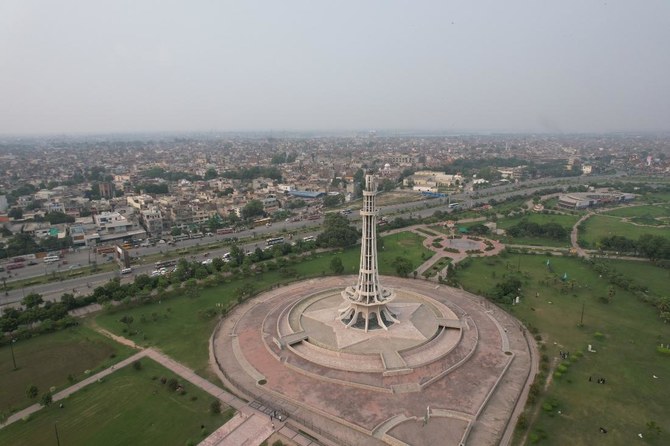
- The blaze fully incinerated the factory and parts of the house
- Blasphemy accusations are common in Pakistan and under the country’s blasphemy laws, anyone found guilty of insulting Islam or Islamic religious figures can be sentenced to death
LAHORE, Pakistan: Police in eastern Pakistan arrested dozens of Muslim men and charged them with attacking a Christian father and son on allegations of desecrating pages of Islam’s holy book, officials said Monday.
The mob went on a rampage Saturday after locals saw burnt pages of the Qur’an outside the two Christian men’s house and accused the son of being behind it, setting their house and shoemaking factory on fire in the city of Sargodha in Punjab province, said senior police officer Asad Ijaz Malhi. They also beat up the son.
Malhi said police forces rescued the two wounded men and transported them to a hospital where they were in stable condition, and that at least 33 men were arrested following multiple police raids. Authorities were chasing others who may be involved in the attack, he said.
The blaze fully incinerated the factory and parts of the house, residents and the police said.
Punjab police said in a statement it beefed up security at churches.
Blasphemy accusations are common in Pakistan and under the country’s blasphemy laws, anyone found guilty of insulting Islam or Islamic religious figures can be sentenced to death. While no one has been executed on such charges, often just an accusation can cause riots and incite mobs to violence, lynching and killings.
The latest violence, however, brought back memories of one of the worst attacks on Christians in Pakistan in August 2023, when thousands of people set churches and homes of Christians on fire in Jaranwala, a district in Punjab province.
Muslim residents at the time also claimed they saw two men desecrating the Qur’an.


